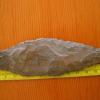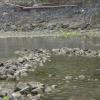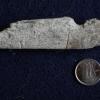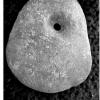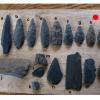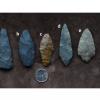Archaeological Heritage
Peering into Lasqueti's Past
Learn how to say Lasqueti's Coast Salish name: Xwe’etay
Click here to view some of the artifacts and sites found on Lasqueti
The archaeological record of Lasqueti, like that of many of the Gulf Islands, bears witness to the island’s rich indigenous heritage. And, consistent with other island communities, Lasquetians feel a deep connection to their island and its history. These web pages are designed both to pay tribute to our island’s ancient heritage and to protect this heritage through education.
What kinds of archaeological sites are on Lasqueti and where are they?
Living on an island means, by definition, that many people will have homes on or near the water. People today choose these places so they can easily access the ocean, which in turn offers transportation and communication routes, sustenance, and, of course, beauty. Ancient people chose to put their homes in the same spots for many of the same reasons.
Our archaeological surveys of the island and perusal of private artifact collections tell us that First Nations used much of the island in the past. Large sites representing permanent settlements are located in almost every bay on Lasqueti These sites are composed of large amounts of mollusk shells and minor amounts of other remains (animal bones, artifacts). In many cases, ancient people created expansive flat, house platforms on otherwise rocky, unlivable surfaces by bringing countless basket-loads of shell from the beach. If these were properly excavated, we would find the remains of 1000s of years of super-imposed floors of longhouses (with hearths, post holes, storage pits, etc.) on top of these constructed platforms. Based on artifact styles, these longhouse villages date sometime within the last 2000-3000 years.
In association with some of the larger seaside settlements on Lasqueti are fish traps where the ancient Lasquetians trapped and sometimes stored the abundant fish of Georgia Strait. Such ancient extraction and management techniques allowed for the relatively high density of ancient settlements on the island. Click here for more information on one Lasqueti fish trap and to view photos.
Indigenous peoples used the inland areas of Lasqueti in two ways. Based on the artifacts people find in their gardens, we can tell that people hunted deer and gathered berries throughout the island’s interior. The form of some of the projectile points suggests people have been camping in Lasqueti’s inland since 6000-8000 years ago.
The second use of the inland was as a retreat during times of conflict. These refuge sites are recognizable by shell located a considerable distance inland and up slope from some of the larger settlements. Such sites are usually on promontories with good visibility out to sea, but as much as 40m above the ocean. Based on archaeological work elsewhere in the northern Gulf Islands, such sites date to the last 1000 years or so.
To find out more about the island and the region’s rich past, read these articles from the Isle & Times about the archaeology of herring and obsidian or go to this web site http://www.sliammonfirstnation.com/archaeology/
The status of Lasqueti’s archaeological heritage
Despite the fact that Lasquetians generally have a strong connection to and respect for our island, we are doing a poor job of protecting our collective archaeological heritage. Not surprisingly, many of the island’s coastal sites were destroyed in the mid 20th century as a result of logging, other development, and early settlements. Since that time, however, with easier access to bulldozers and backhoes, and increasing demand for waterfront property, the rate of archaeological site destruction on Lasqueti has increased greatly. Unless we make a concerted effort as a community to slow down the destruction of sites, the record of Lasqueti’s deep history will be lost forever.
To find out more about the laws that protect Lasqueti’s archaeological sites and your rights and responsibilities if you have an archaeological site on your property, read these two Isle & Times articles from 2002 and 2005.

